Outgassing of space materials, screening tests for COTS components
- Posted by Alejandro Herrera
- On December 3, 2019
- 0
CONTENTS
- INTA-OUTGASSING LABORATORY, BRIEF OUTLINE.
- OUTGASSING EFFECT DESCRIPTION.
- OUTGASSING SOURCES-MATERIALS.
- INFLUENCE OF OUTGASSING ON SPACECRAFT.
- OUTGASSING TESTS AND BAKE OUT IMPLEMENTATION.
- STANDARD TEST METHOD APPLICATION: ECSS-Q-ST-70-02C / ASTM E 595.
- OUTGASSING TEST FACILITIES.
- OUTGASSING TEST DATA AND EVALUATION OF COTS PROPOSED FOR SPACE APPLICATIONS
1. INTA-OUTGASSING LABORATORY, BRIEF OUTLINE.
INTA (National Aerospace Institute)
Public Research Organism, Ministry of Defence, research & technological development in aeronautics, space , terrestial and hydrodynamics systems – security and defence.
Outgassing Laboratory
Created in 1970 in collaboration with ESRO -ESTEC MATERIALS SECTION (1968)-> Development of 2 outgassing high vacuum facilities. Damage from molecular contaminations were detected in optical systems and outgassing test development and standarization was required. Certified by ESA every 4 years. Test > 120 material samples per year proposed for space application. 2019: test on > 200 different type of material samples will be completed.
ESA -VALIDATED OUTGASSING TEST HOUSE → SUPPLIER FOR AEROSPACE FIRMS

2. OUTGASSING EFFECT DESCRIPTION.
What is Outgassing….
Release of volatile molecular compounds from a material, contained in it or adsorbed on the surface, due to the exposure to space vacuum environment. It is a process activated and accelerated with the increase of temperature. It is the main effect provoqued by the extreme vacuum (from 10-5 – 10-7 mbar low orbits, i.e: ISS, to < 10-13 mbar deep space)
Space environment:
- Temperature
- Vacuum——————————————- > OUTGASSING EFFECT.
- Radiation.
- Space debris
- Micrometeorites
- Atomic Oxygen
Outgassing mechanisms
Outassing can be produced according to next processes:
- Desorption : molecules adsorbed on the material surface.
- Evaporation/sublimation: change of physic state of material to gas phase.
- Diffusion: random motion within the material of concentrated molecular species.
- Decomposition: chemical reaction on material, generation of outgassing species diffusion desorption release to vacuum (outgassing).
- Permeation: molecular flux can permeate a material, diffuse, and later be released after to vacuum space.
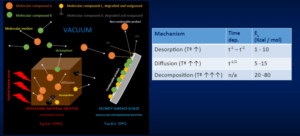
Outgassing mechanisms, analytical approach
Desorption
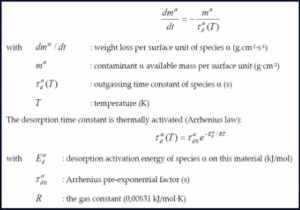 Desorption is the release into vacuum of molecules that were adsorbed on top of a materials.
Desorption is the release into vacuum of molecules that were adsorbed on top of a materials.
Molecules are initially linked to the material by weak forces (physisorption) or stronger forces (chemisorption). The random thermal movements of a molecule may allow it to leave the resulting potential wall to vacuum.
Evaporation/sublimation
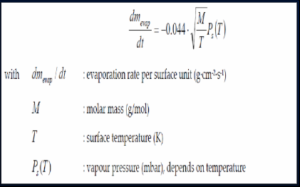 Evaporation is the passage of contaminant from its condensed phase (liquid or solid) to gas phase. The contaminant is thus implicitly assumed to be present as a thick layer on top of the material (many monolayers). For a pure chemical compound evaporation follows zero‐order Langmuir law.
Evaporation is the passage of contaminant from its condensed phase (liquid or solid) to gas phase. The contaminant is thus implicitly assumed to be present as a thick layer on top of the material (many monolayers). For a pure chemical compound evaporation follows zero‐order Langmuir law.
Diffusion
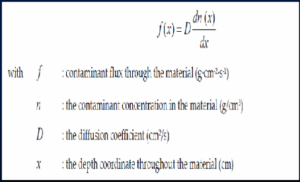 Contaminant molecules can be located deep inside a material. The random motion of these molecules within the material is called diffusion. Those reaching the vacuum exposed surface of the material can further be desorbed to vacuum.
Contaminant molecules can be located deep inside a material. The random motion of these molecules within the material is called diffusion. Those reaching the vacuum exposed surface of the material can further be desorbed to vacuum.
3. OUTGASSING SOURCES-MATERIALS
Materials outgassing, main sources….

- Polymer or macromolecular materials, comprising low relative molecular weight molecules, that can contain concentration of volatile variety of mixed chemical compounds in a complex formulations. Weakness of the linkages between molecular structures in polymers also make them prone to outgassing.
- Certain metallic materials can also outgass, such us Zn that can sublimate under vacuum at heating (150ºC) or Cd (100ºC), but at lower order of magnitude compared with polymers, metallic depositions can be critical and must be avoided also.
Standarized type of space materials prone to outgassing:
Optical materials, adhesive tapes, coatings and varnishes, paints, inks, lubricants and greases, pottings, sealants, foams, reinforced plastics, fabrics, rubbers and elastomers, thermoplastic materials, thermoset materials, cables , ceramic and glass materials, miscellaneous, metallic materials, surface anodized treatments, etc.
Electronic and microelectronic materials /COTS
- Plastic materials made of complex compounds. Formulations can include i.e : epoxy resin, silicones, urethanes, hardening compounds, accelerators, fillers, flame retardants, couplers, stress relief additives, mold release additives, coloring, and ion–getters among others. LCP with metal treatments.
- Typically proprietary formulation of a specific parts resin (i.e: encapsulating), and various types of additives, which provide the desired properties (i.e: for the packaged device).
Main factors determining outgassing levels,
Material processing
Material is not validated itself, validation of particular processing for specific application is required for space use or concrete mission.
- Chemical nature of materials.
- Formulation.
- Manufacturing process.
- Curing parameters / process and other treatments (i.e. baking).
- Environmental conditions/storage.
- Preparation/application methods.
typical chemical compounds outgassed /deposited
epoxy, silicone, polyamide , dyciandiamide, polyurethane, acrylic, fluorocarbons, polycarbonates, acetals, ester compounds, hydrocarbons, water vapour , etc..
- Residual concentration of monomers non reacted after polymerization process.
- Concentration of volatile additive or agent compounds present in the polymer (flame retardant, plastificier, estabilizer agent, hardeners, etc.).
- Contaminants, compounds resulted from chemical reactions, absorbed or trapped during material processing.
- Excess of humidity (water vapour could be critical contaminant)
4. INFLUENCE OF OUTGASSING IN SPACECRAFT
Detrimental effects of outgassing on materials and components
- Degradation of functional properties of materials (i.e : outgassing of functional additives).
- Molecular or chemical contamination on component surfaces, affecting the performance (i.e:degradation of optical, thermal, electrical properties).
- Perturbation of the spacecraft medium (i.e: voltage breakdowns, arcs, heat transfer problems)
SYNERGISTIC EFFECTS -> Interactions between a material and the different environments to which it is exposed are quite often synergistic and not simply additive; i.e. the sum of both interactions is larger than each of the effects separately.
(i.e: radiation UV, P+, e– molecular degradationoutgassing increase)
5. OUTGASSING TEST AND BAKE OUT IMPLEMENTATION
Outgassing testing
Screening outgassing tests
Std. ref.: ECSS-Q-ST-70-02C / ASTM E 595
Implementation of general criterium for material acceptance/rejet, in the materials selection step for space application, and reject those with high levels of outgassing. The general standard limits are:
- 1,00% Total mass loss (TML/RML).
- 0,10% sample mass, for Collected Volatile Condensable Material (CVCM).
- More stringent values can be used, for specific critical cases (i.e: in optical applications, CVCM < 0,01%— “Ultra Low OutgassingTM requirements” < 0.1 % TML and < 0.01 % CVCM).
The test is performed at one standard temperature of reference: 125ºC sample, and 25ºC for collector plate for condensables, on samples in the order of 100-300 mg mass.
Kinetic /dynamic outgassing tests
Std. ref.: ECSS-Q-TM-70-52A / ASTM 1559
Mesurement of outgassing/deposition rate characteristics with time, under selected values of different heating sample and cold condensable collector temperatures outgassing long term predictions. The method include the use of Vacuum balances / QCM Quartz Crystal Microbalances (ESA / ASTM configurations).
Data from this tests allow to compute contamination models and simulate contamination processes in the designed systems, as well as provide further information of outgassing characteristics more than simple data obtained from screening tests.
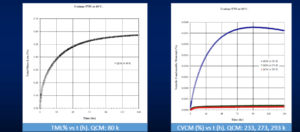
i.e: Kinetic Outgassing test on polymer for electronics
Material: Uralane 5753. (polyurethane). Thermally Conductive Potting/Staking Compounds. Conductive heat transfer from electronic assemblies.
Mass sample: 4851.96 mg. Sample size: (4 x 4 x 0,3) cm3. Sample Tª: (EFFUSSION CELL): 60ºC.
CVCM Tª QCMs: QCM1: -183ºC. QCM2: -40ºC. QCM3: 0ºC .QCM4: 20ºC
Temperature time: 144 h.
Vacuum : 10-10 – 10-8 torr. View factor: -QCM: 415 cm2. QCMs sensibity: 4.43×10-9 g/cm2/Hz.
Kinetic /dynamic outgassing tests: standard method ESA
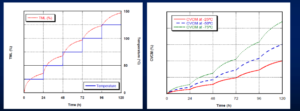
Bake out under vacuum
The purpose of this activity, is to evacuate the excess of possible volatile compound of the material or molecular contamination on hardware to reduce or eliminate the potential outgassing or in a cleaning process for the removal of residual contamination after solvent application (i.e: IPA) or humidity excess. A material or component is heated under vacuum for a certain period of time (normal practice is between to heat 70-125 ºc under mid – high vacuum , 10-2 – 10-5 mbar , for 72 h or more).
It can be done also in controlled atmosphere.
6. STANDARD TEST METHOD APPLICATION: ECSS-Q-ST-70-02C / ASTM E 595
Screening outgassing test ECSS-Q-ST-70-02C / ASTM E 595
Aplicability
- Determination of outgassing screening material properties, not for outgassing simulations.
- Reliable for operating temperatures below 50ºC in general.
- The validity of this test, depends on the environmental conditions during the lifetime of the material as well as the vicinity of critical or sensitive surfaces (i.e: for higher temperatures is questionable).
- Not reliable for temperatures > 50ºC for extended period of time , or > 125ºC for short period of time—dedicated test progamm is required.
Test standard conditions
- SAMPLE MASS: 100-300 mg (metal parts excluded)
- SAMPLE TEMPERATURE: 125ºC.
- COLLECTOR COLD PLATE TEMPERATURE: 25ºC.
- TEST DURATION: 24h.
- VACUUM PRESSURE: high vacuum range, 10-6 – 10-7 mbar.
In order to control the balance of water vapour absorbed/desorbed, samples are conditioned before and after the test at 22ºC , 55 HR%, 24h.
Test parameters measured : in % of the tested mass sample
TML%: Total Mass Loss (total mass outgassed just after test)
RML%: Recovered Mass Loss (total mass outgassed after 24 h water vapour mass recovering)
WVR%: Water Vapour Regained (TML% -RML%)
CVCM%: Collected Volatile Condensable Material (mass of condensed product on collector plates
Determination of CVCM nature by spectrometry techniques (i.e: FTIR, GC-MS)
Test process illustration

Test sample configuration
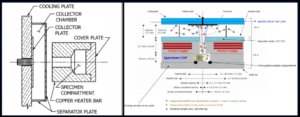
Sample basic preparation
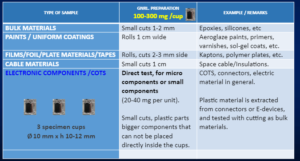
Introduction of COTS samples in specimen cups for test
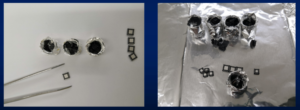
7. OUTGASSING TEST FACILITIES
Screening outgassing test ECSS-Q-ST-70-02C / ASTM E 595
Outgassing test facilities : vacuum technology application
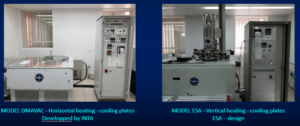
Outgassing test facilities: DMAVAC system –vacuum chamber
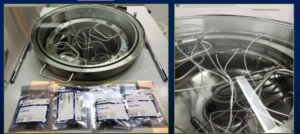
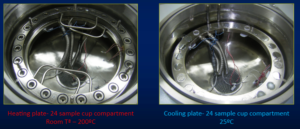
Outgassing test facilities: ESA vertical system- vacuum chamber
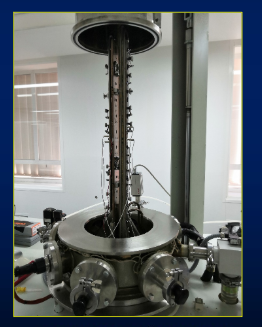
Outgassing test facilities: Examples of condensable products procuced by outgassed samples (25ºC)
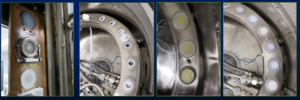
Outgassing test facilities: HIGH TEST VACUUM GENERATION: Turbomolecular pump
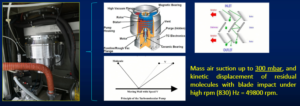
Outgassing test facilities: HIGH TEST VACUUM GENERATION: pump features
- Test chamber able to reach 10-5 mbar < 1 h, vacuum range 10-6 – 10-7 mbar is obtained after 3-4 hour running with turbomolecular pump.
- Pumping speed S = 2100 l/s.
- Thoughput Thp = 30 mbar · l · s-1 : capacity of the pump to recover the vacuum level < 10-5 mbar when pressure is increased during initial outgassing of samples (higher rate in the first 1-2 hour of the test run)
- Range 10-6 – 10-7 mbar , is valid to reproduce extreme vacuum conditions in deep space, (< order of 10-12 mbar).
8. OUTGASSING TEST DATA AND EVALUATION OF E-COMPONENTS AND COTS PROPOSED FOR SPACE APPLICATIONS
Screening outgassing test ECSS-Q-ST-70-02C / ASTM E 595
Test experience on several E-components / COTS materials
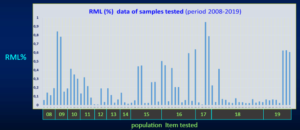
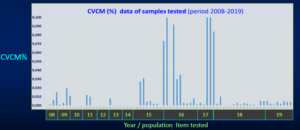
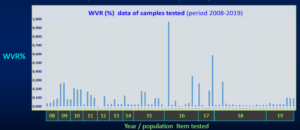
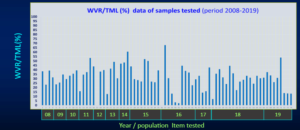
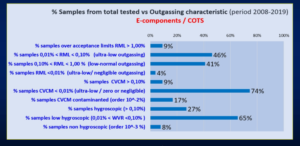
- Outgassing of space materials, screening tests for COTS components - December 3, 2019

0 comments on Outgassing of space materials, screening tests for COTS components